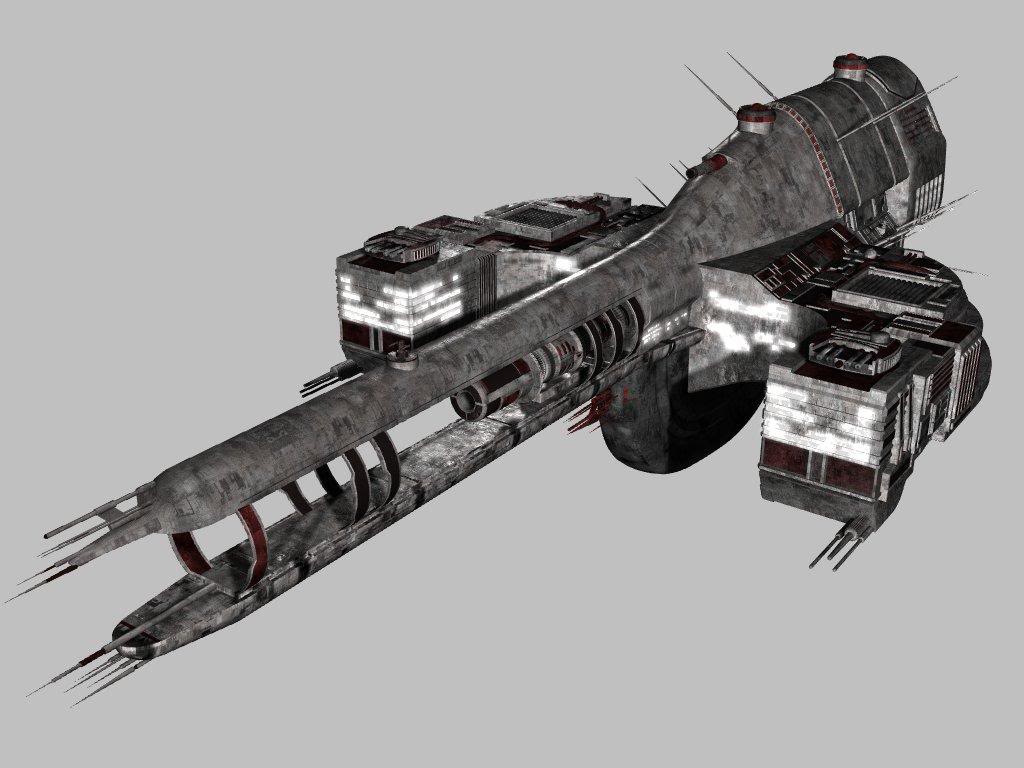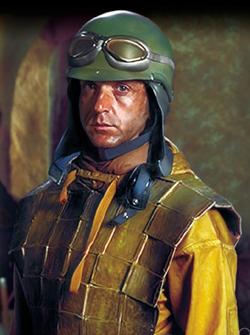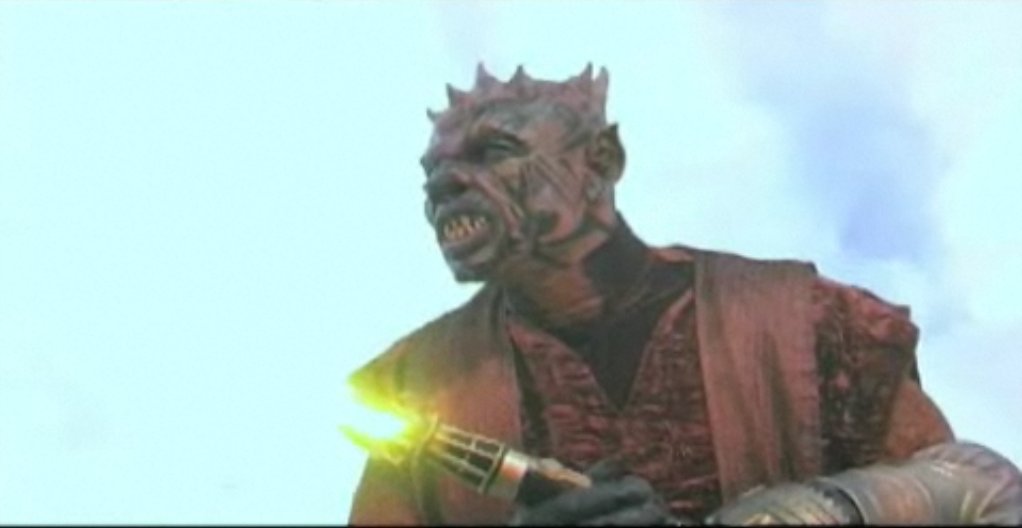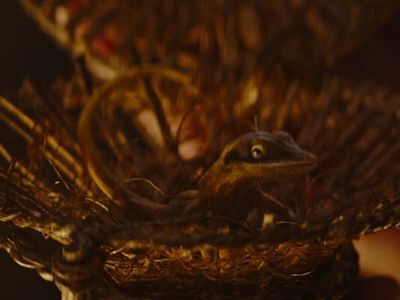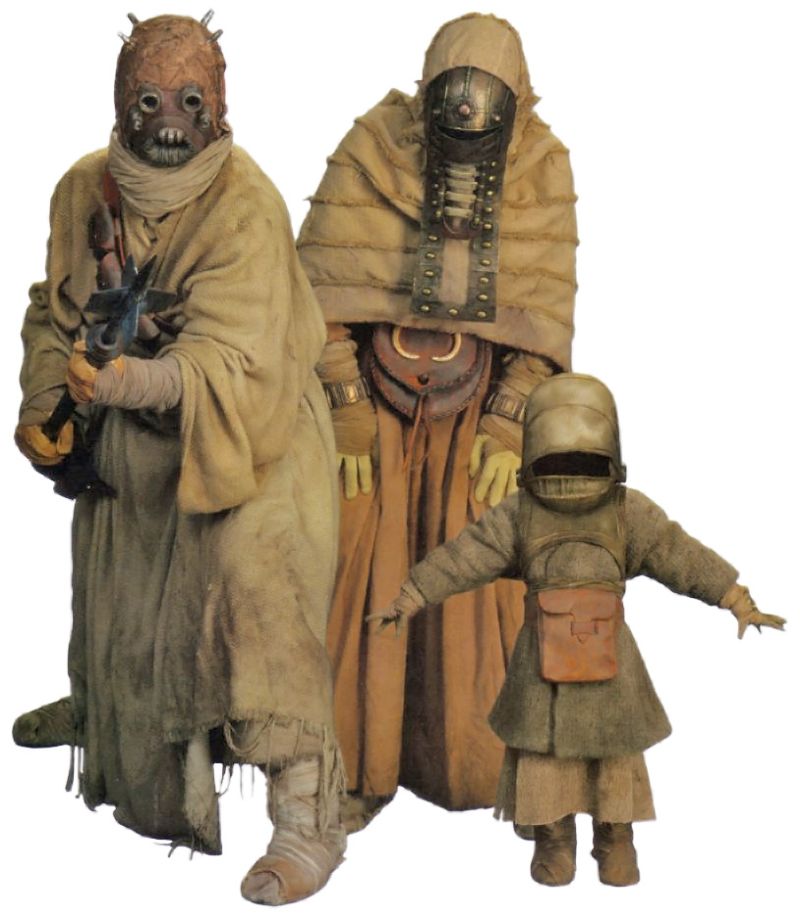 Name: Tusken Raider (Sand People)
Designation: Sentient
Average height: 1.85 meters
Average mass: 89 kilograms
Homeworld: Tatooine
Language: Tusken
Attribute Dice: 12D
DEX: 1D/4D+1
KNO: 1D/4D+2
MEC: 1D/3D
PER: 1D/4D
STR: 2D/5D
TEC: 1D/3D
Special Abilities:
Born Survivors: Sand People are raised in the desert and tempered by it, making them capable of surviving in environments far tougher than most species can. This gives them a bonus +2D to all Survival checks.
Dry: The Sand People manage their water use because of the arid environment they come from, only requiring 50% of the water that most species require.
Story Factors:
Technological Distrust: Stories from ancient Storytellers of the Tusken speak from a disaster on Tatooine long ago, the Tusken had made there living under the surface of the planet and returned as survivors to the desert. As a result Tusken distrust High-Tech and get a strong survival feeling of unease around it.
Masked: Due to their harsh environment, Tusken Raiders always go masked and robed to save every drop of water. This has become almost religious to them, as they cover themselves at all times and do not show their faces except at very special times such as marriage and child birth.
Move: 10/12
Description: Tusken Raiders, less formally referred to as Sand People or simply as Tuskens, were a culture of nomadic, primitive sentients indigenous to Tatooine, where they were often hostile to local settlers. The term Sand People was given to them due to their existence in the desert, and was in use from at least around 4000 BBY; but the more formal name of Tusken Raiders was acquired much later, due to a period of concerted attacks on the settlement at Fort Tusken in 98-95 BBY. Although this name was often used as a common term for the race, it actually referred only to the participants of the attack on the settlement.
Specialists studying the past of the Tusken Raiders also used the term Ghorfa to denote an earlier sedentary phase of their culture, and lastly Kumumgah, which is what Tusken Raiders evolved from, as they were the earliest stratum of sentient civilization on the planet, believed by some to represent a common ancestry shared by the Ghorfa and the Jawas. In the culture of the Tuskens, to expose any part of the flesh was forbidden and seen as a disgrace.
Biology and appearance
A'Sharad Hett stated, while on a mission to Aargonar with Anakin Skywalker, that Tusken Raiders were biologically incompatible with Humans. This implies that Tusken Raiders were a non-Human species.
Sand People were known to adopt settler orphans, such as K'Sheek, after raids on Human settlements and convoys, in a similar fashion to Mandalorians. Also, the Jedi Knight Sharad Hett won a place in their tribes through his great combat prowess. Beyond these isolated and uncommon incidents, there is no indication that Humans were present in any great number among the Tuskens.
The lack of detailed knowledge about Tusken Raiders can be accounted for in part by the hostility of the Tatooine climate, and in part by the hostility of the Tusken Raiders themselves. Scientific studies of the few corpses found were said to have been inconclusive, and knowledge of the Sand Peopleââ¬âor what was thought to be known about themââ¬âwas often based on uncertain and inferential evidence. However, A'Sharad Hett's claim that he learned of the Tusken-Human incompatibility, combined with his firsthand knowledge of the Tuskens, is compelling evidence that they were a different species.
It is thought that Tuskens and Jawas shared common ancestry in the Kumumgah, who were taken off world by the Infinite Empire to work as slaves on other planets. In fact, the Sand People were one of the slave races used in construction of the Star Forge by the Rakatans. Since the Kumumgah were considered a possible origin species for Humanity, it is possible that Tuskens and Humans shared ancestry; however, the connection was not close enough to allow inter-breeding, and their unmasked appearance was distinctive. Anakin Skywalker recognized immediately that the unmasked A'Sharad Hett was not genetically a Tusken Raider; this indicates that he was familiar with the appearance of Tuskens under their masks. Later, Skywalker had a nightmare in which a Tusken appeared partially unmasked; however, it is not known whether this appearance represented their true form or was simply a "boogeyman," derived from Anakin's imagination.
The Grave Tuskens, a group of warriors that had pledged allegiance to a Dark Jedi named Maw, flaunted their bare faces, which provided a little information about their species' traits. The Tusken Raiders had grayish skin tones, dark eyes, and a short, feline muzzle.
Along with Ewoks and Vulptereens, Tusken Raiders are among the species without the mental aptitude necessary to become Jedi.
Society and culture
Tusken culture was defined first and foremost by the climatic extremes of Tatooine: barren wastes stretching for days' journey on end, scoured by harsh, arid winds and searing heat by day; icy, deadly stillness after dark.
Practical survival was the first priority in terrain like this, and to protect themselves, the Sand People learned early in their existence to cover themselves from head to foot in desert-colored rags and robes, leaving no bare skin exposed to the elements. It is perhaps no surprise that these outward trappings came to be the most basic tokens of Tusken Raiders' identityââ¬âtheir mode of dress was, after all, a direct expression of their way of life. The Sand People never take off their robes except in the most private of moments. Even in death, they do not remove their robes.
The Tuskens were divided into small tribes or clans, and roamed widely across the desert surface of Tatooine, but the focus of their habitation patterns seems to have been the Jundland Wastes, the one major area of rocky upland that rose clear of the shifting sands: in particular, the traditional sandstorm-season encampments of many clans were concentrated in an area known as The Needles. Occasionally the different clans would go to war over territory and would even unite under a powerful warlord. They raided widely through both the Jundland Wastes and the Dune Sea, and any creatures, particularly offworlders, were subject to their savage attacks. Traveling on trained banthas, raiding parties would swiftly appear from the desert, riding in single file to conceal their numbers, and then disappear back into the cover of the dunes with their trophies and prisoners. Due to their lack of advanced technology, primitive society, and viciousness, they were regarded as barbaric monsters by most of the galactic populace.
Although Tusken garb varied from tribe to tribe, certain aspects of dress remained constant. The eyes of Sand People were covered with goggles or visors which shielded them from the harsh sunlight. Covering their mouths, Tuskens had a filter to help facilitate breathing in the desert. A constantly open mouthpiece covered the area between the nose and jaw, while a moisture trap worn around the neck humidified the air taken into the lungs. Sand People were also recognizable by their fierce gaderffii weapons. The gaderffii was so integral to their culture that Tuskens would often commit ritual suicide in the event that an injury made them unable to properly wield the weapon. While rejecting most examples of modern technology, long-barreled Tusken Cycler rifles and stoves made of scavenged or stolen metal were not uncommon.
Female Tuskens wore variations of the male Tusken garb (though in some tribes, like A'Yark males and females wore the same), often incorporating womp rat tusks into their attire. In some tribes, their role seems to have involved maintaining the encampments while the males raided and hunted, but in other groups, perhaps more strictly nomadic in outlook, they may have lived and hunted more closely alongside their menfolk. Tusken children wore unisex masks and clothing; gender-specific coverings were not allowed until they became adults.
Tuskens were forbidden to take off their protective clothing in front of others, except in a few very specific circumstances: at childbirth, on their wedding night, during coming-of-age rituals (two events which were often one and the same), and as adults, only in the privacy of their tents with their blood-bound mates. Breaking this rule meant either banishment or death, depending on the specific tribe rules.
The emphasis on outward appearance and concealment of physical form also enabledââ¬âand disguisedââ¬âone of the most striking elements of Tusken culture: although the Sand People were regarded as alien savages by Tatooine's Human colonists, an unknown proportion of the Tusken population were, at least by the last decades of the Galactic Republic, every bit as Human as the settlers themselves.
One tribe near Mos Espa had burial grounds and was led by a war chief. The tribe abducted Sabé, in the guise of Queen Amidala, in 32 BBY, but the war chief was defeated by the Jedi Padawan Obi-Wan Kenobi.
Social organization
Sand People organized into clans and tribes, the former being kin groups of between 20 to 30 beings, and the latter being larger affinities with no strict bounds. In a typical tribe, the adult males typically assumed the role of hunter and protector, often leaving their camps for an extended period of time. Females, often accompanied by massiff guard animals, cared for the children, known as uli-ah, and the seasonal camps. After completing the rites of adulthood at the age of fifteen, the uli-ah were granted full status within the tribe and paired for marriage in a ceremony involving blood exchanges between the male, the female, and their banthas.
The bantha was another vital element of Tusken culture, a large, shaggy-coated quadruped capable of surviving for long stretches in the harsh terrain of the deserts; some banthas roamed wild, but the Sand People had learned to domesticate them. Every Tusken had their own mount from childhood, and they rode bantha-back for journeys of any length: small scouting parties of two or three mounts, or entire clan communities on seasonal migrations, they traveled through the dunes and rock formations on the shoulders of their mounts, in single file.
Tuskens subsisted primarily on hubba gourds, and moisture farmers found great humor in the fact that they became intoxicated on just a few sips of sugar water.
While leading a lifestyle that was primarily nomadic, when the hot season was at its height, semipermanent camps would be constructed. Particular caves or hollows, spiritually connected to certain clans, were frequently visited, and were usually where the dead would be buried or special ceremonies would be held. Special water wells such as the one in Gafsa Canyon, sacred due to their rarity, were often vehemently protected.
In each tribe, a small number of individuals would be trained from birth to become Storytellers, orally learning the tales of their ancestry with perfect accuracy. This tradition was such a large part of Tusken culture that Storytellers were considered the most important members of a tribe. On the other hand, written communication was believed to cheapen the value of Tusken history, and was therefore shunned. There was only one accepted history across the many Tusken tribes, and if someone questioned or spoke even a single word of the histories incorrectly, it was considered a blasphemy punishable by death.
Thus, Tusken history was passed down orally from generation to generation with almost no alterations in the material. If the Storyteller of a tribe died before the training of their apprentice was complete, the tribe was considered to be unworthy of existence and would quickly destroy itself through infighting. In rare circumstances, those that proved themselves worthy, such as great warriors, were also permitted to listen to the teachings of the Storyteller.
Mythology and Customs
The history of the Tusken Raiders as passed down through Storytellers was considered a single, indivisible entity that took hours to recite. Circa 4000 BBY, its contents related their entire known ancestry: their origins as the technology-loving Kumumgah, their enslavement by the Rakata whom they called "the Builders," which catalyzed the realization of the importance of a connection with the land, their revolt against the Builders and the subsequent desertification of Tatooine, a long account of tribal wars and their evolution into a desert people, and finally the colonization of their planet by the Galactic Republic.
The translator droid HK-47 believed that the histories were likely created thousands of years after some of the events themselves actually occurred, leading to an mythologized demonization of the Rakata that could have distorted elements of the truth. For example, the Tusken understood the Builders as an iconic force meant to test the resolve of their ancestors, rather than the Rakatan race that conquered Tatooine. Additionally, the histories stated that the Kumumgah that were most arrogant and uncaring of the land were exiled from Tatooine by the Builders, a story that HK-47 believed was fabricated and merely symbolic of the removal of certain aspects of society via off-world enslavement. HK-47 also suggested overuse of resources as an alternative explanation for the desertification of the planet.
Traditional Tusken history holds that, following the bombardment and desertification of their planet, their holy warriors drove off the Rakata oppressors through a heroic struggle. However, HK-47 suggests that this belief may be incorrect and that the Rakatans may have simply departed thinking that their bombardment of the planet had "sterilized the problem."
The Tusken believe themselves to be a part of the land and regard anything that might separate them from it as sacrilege. This leads them to accept only in garments that have been sanctified and only ride banthas that they believe retain a connection to the land. Any form of technology or clothing used by offworlders is believed to separate them from the land and is considered sacrilege. This leads them to not only reject foreign technology themselves, but also to viciously attack anyone on their land who employs it.
The mythology of the Tusken also explained their hatred of outsidersââ¬âoutsiders reminded the Tusken of their past as the technology-dependent Kumumgah, either physically or socially. HK-47 suggested that there may also have been a lingering fear that the outsiders were the descendants of the tainted individuals that had been abducted by the Rakata.
They believe that Tatooine's two suns were beings called the Sky Brothers, with the elder having attempted to kill the younger. His failure caused him to start a lifetime of running, his younger brother chasing him to kill him for his treachery.
Rituals
Many rituals held Sand People society together. In many tribes, adolescent Sand People were tasked with a ritual known as "bloodrite," in which a youth proved his or her hunting skills by capturing a creature and fatally torturing it with techniques extending the pain for weeks before death. Most opted for creatures like dewback or desert hulak wraid, but the greatest prestige was reserved for a hunter who performed the rite upon a sentient being. The most prestigious test of an adult male was to hunt and slay a krayt dragon, and retrieve a pearl from its stomach. Oftentimes, members of the tribe would create spirit masks out of natural materials for use in the ensuing ritual and celebration.
Additionally, Tuskens occasionally enjoyed firing upon podracers who participated in the Boonta Eve Races, as a sort of sport and show of marksmanship, and as retaliation for the intrusion of their lands.
A unique bond existed in Tusken culture between the riders and their bantha mounts, and when a mount died, the rider was often left behind to wander the desert alone. They held that if the fallen bantha's spirit wished for the rider to find a new mount, it would be so. If not, the rider would die amongst Tatooine's endless dunes. A Tusken who returned with a new mount would be held in great esteem by his tribe. The bond worked both ways, as accounts have been told of riderless banthas intentionally stampeding over cliffs. The rest of the tribe considered the unbonded individual to be pitiable, but did not scorn that person. Han Solo and Luke Skywalker witnessed the exile of one Sand Person who had lost his bantha in 12 ABY.
Anakin Skywalker became a legend after he slaughtered a tribe of Sand People out of revenge for killing Shmi Skywalker Lars. He was depicted as a vengeful ghost or desert demon, and the Tuskens made ritual sacrifices to ward him off, putting stolen artwork and other valuablesââ¬âeven Human sacrifices, such as Kitster Banaiââ¬âin the place where the tribe was murdered.
Language
The Sand People spoke a guttural language known as Tusken. Many individual names were long and marked by numerous stops, such as Grk'Urr'Akk, Grk'kkrs'arr, Orr Agg R'orr, Orrh Or'Ur and Orr'UrRuuR'R. However, shorter names like Sliven were also recorded in some clans, and some Tuskens, like A'Sharad Hett and his mother K'Sheek, bore patronymic (and perhaps matronymic) names formed from a parent's given name and a prefix: A' meaning "son of" and K' apparently "daughter of."
Other known Tusken words include urtah (carrying pack) and urtya (light tent). As a rule, Tuskens also possessed a rudimentary knowledge of Huttese and Jawaese, as they came into contact with these languages quite frequently.
When they still were known as the Ghorfas, the Sand People did use a form of logographic writing system, but it apparently fell into disuse with the decline of their civilization. The complex writing had degraded into mere crude symbols. With no written language, the Sand People thus relied on oral history to pass down the legends and stories of their people. As such, storytellers were held in the highest regard and charged with the responsibility of memorizing by rote the story of every clan member and piece of clan history. For apprentice storytellers, the pressure to memorize the stories precisely was intense: a single mistake meant death. If an apprentice storyteller successfully recited a story perfectly, he became the clan's storytellerââ¬âwhile the old one wandered off into the desert forever.
During the Clone Wars, a Tusken language pack was sold as an enhancement for protocol droids, which enabled them to acquire the Tusken language.
Common weapons
Czerka 6-2Aug2 "Tusken Cyclone" hunting rifle (long range)
Gaderffii (mid-range)
Hook-tipped Gaffi club (short range)
Sand bat venom-spray (short range)
History
According to history as passed down through Storytellers, the evolution of the Tusken Raiders could be traced back to the Kumumgah, a technologically advanced race that once built great cities all over the then lush world of Tatooine. Over millennia, the Kumumgah achieved space travel among the worlds of the Outer Rim and beyond, attracting the attention of the Rakatan Infinite Empire, who conquered, enslaved, and annexed Tatooine. Some time before 25,200 BBY, the Kumumgah rose up against their Rakatan masters, but were punished by orbital bombardment and left for dead. The bombardment slagged the surface of Tatooine into little more than fused glass, which eventually crumbled into desert sand. The Kumumgah, however, had anticipated such an act, and survived by taking refuge in caves across the planet. Over time, they diverged into two separate species, Jawas and Ghorfa.
The Ghorfa spent the next thousands of years as a nomadic society, attempting to come to terms with their new identity in a period they called "the long walk." After Tatooine was rediscovered by the Galactic Republic in around 5000 BBY, early Human settlers were believed to have disrupted the water-supply of a settled cave-dwelling society known as the Ghorfa culture, precipitating the transformation of the natives into the Sand People. To survive, they were forced to steal and adapt the technology of the colonists, forging the distinctive desert survival gear by which they would subsequently become so well-known. By around 4000 BBY, they were also engaged in endemic low-level warfare with the settlers, raids which were among the factors that forced Czerka Corporation to abandon their attempts to operate Tatooine as a mining world.
Tatooine was, it seems, largely forgotten by the wider galaxy for the next few thousand years, and indeed, the planet apparently had to be formally rediscovered in 1100 BBY. By the sixth century BBY, however, a mining colony had been reestablished, and the key moment in the history of the Sand People and their relations with the outlanders occurred around 550 BBY, when they encountered an offworlder and rogue named Alkhara.
Initially, Alkhara was an operative of the colony's Bureau of Ethnicity and Socialization, studying the Sand People, and seemingly gaining their trust. Eventually, however, he turned against the colonists and occupied the desert fortress that was used in earlier centuries by the B'omarr Order and in later centuries by Jabba Desilijic Tiure's criminal empire. It is not clear how closely his banditry was connected with his relations with the Sand People, but in the most notorious incident of his career, he allied himself with a group of Sand People whose bivouacs lay on the Great Mesra Plateau to wipe out a police garrison, then afterwards turned on his Sand Person confederates, and destroyed their camp. This, it is claimed, was the source of a subsequent blood feud between the natives and the outlanders.
Permanent settlement by offworldersââ¬âor outlandersââ¬âonly seems to have resumed in 100 BBY, with the arrival of the settler ship Dowager Queen from Bestine IV. A new planetary capital called Bestine was founded, and a second settlement called Fort Tusken was established at the northern tip of the Jundland range. At first, the new colonists seem to have been unaware of the Sand People, but a series of attacks between 98 and 95 BBY forced the abandonment of Fort Tusken, and from that point on, the Human settlers of Tatooine referred to the natives as "Tusken Raiders."
Sometime after Biggs Darklighter left Tatooine, there was a lot of unrest among the Tuskens Raiders. They raided even the outskirts of Anchorhead.
|









